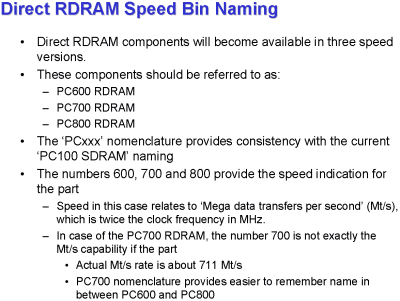Intel Roadmap Update June 1999 Part 3: Desktop Chipset and Mobile CPU Roadmap
What The Roadmap Says About RDRAM
There seems to be a little problem in the production process of RDRAM. Currently, it's very difficult to manufacture RDRAM that runs at 400 MHz. This was the one type of RDRAM that Intel was talking about in the past. Now it's only going to be available in small quantity at most likely very high prices. The result is that the parts that wouldn't pass the tests at 400 MHz are either 'downgraded' to run at 356 MHz or if even this test fails the 'scrap' can still be sold as PC600 RDRAM, running at 300 MHz. The PC700 = 356 MHz version is nothing else but the confession of RAM-makers that they can't supply the 400 MHz product. It was quickly invented to have something that can at least be sold more expensive than the PC600 RDRAM. That's why 'Carmel' or i840 can't run it, the PC700 standard came through too late.
The above picture simply states my comments, PC700 was only just 'created' and it's of course important to explain that PC700 is even intoxicatingly faster than it sounds!!! 22 MB/s more than 1.4 GB/s makes a difference of even 1.6 % !!! Thank you Intel for pointing out this highly important issue, I'm sure I would have noticed that when running my system. I would have said "well, I guess my system is running even faster than PC700, it feels like some 1-2% really!!"
Camino or i820 will support PC100 SDRAM as well now, as already mentioned in my Computex-article . This solution was not planned in the first instance, the only plan to make SDRAM run with Camino was supposed to be a RIMM-riser card in which you could plug your old SDRAM. This riser card won't only be pretty expensive, it will also be a complete performance killer, because it translates the serial Rambus interface back into the parallel SDRAM interface, increasing latency even more. A comparison of RDRAM vs. SDRAM on a riser card would have a clear outcome, SDRAM would lose out big time with this rather cheesy solution. Now motherboard makers can include an 'MTH'-chip (Memory Translation Hub ??) onto the board, which talks directly to maximal two DIMM slots. We'll see what kind of performance will be achieved with this complicated solution, I doubt that it will be any better than our good old BX, it might be even slower.
Get Tom's Hardware's best news and in-depth reviews, straight to your inbox.
Current page: What The Roadmap Says About RDRAM
Prev Page What Will Be The Benefit Of RDRAM? Next Page I840 Or 'Carmel'
